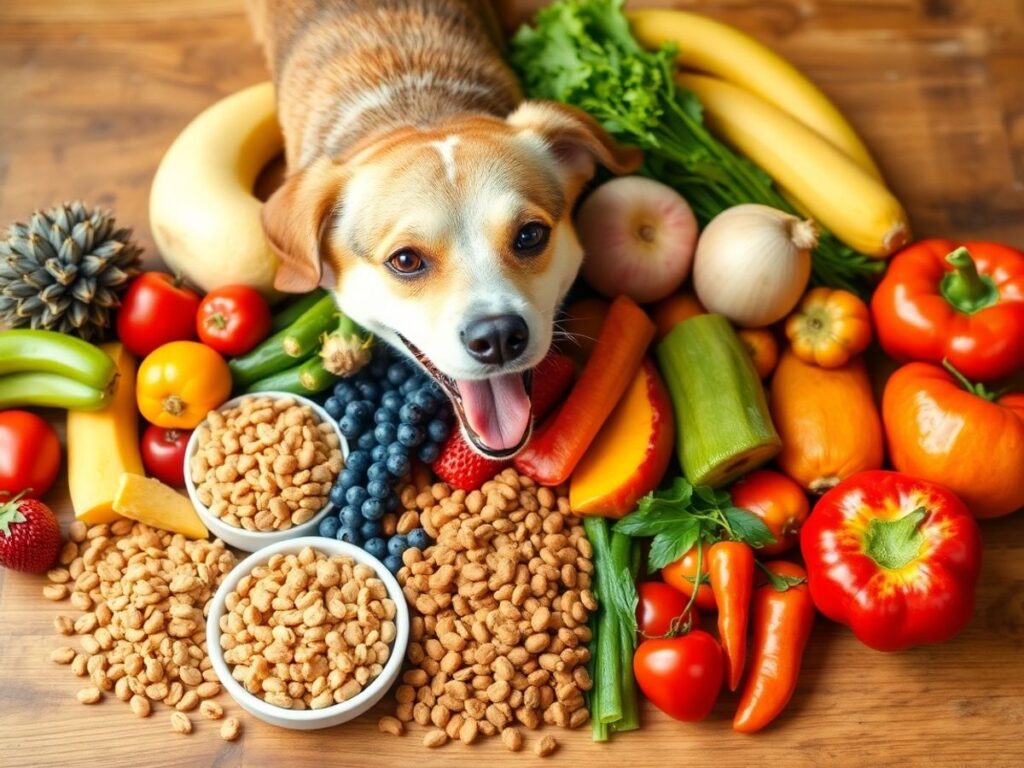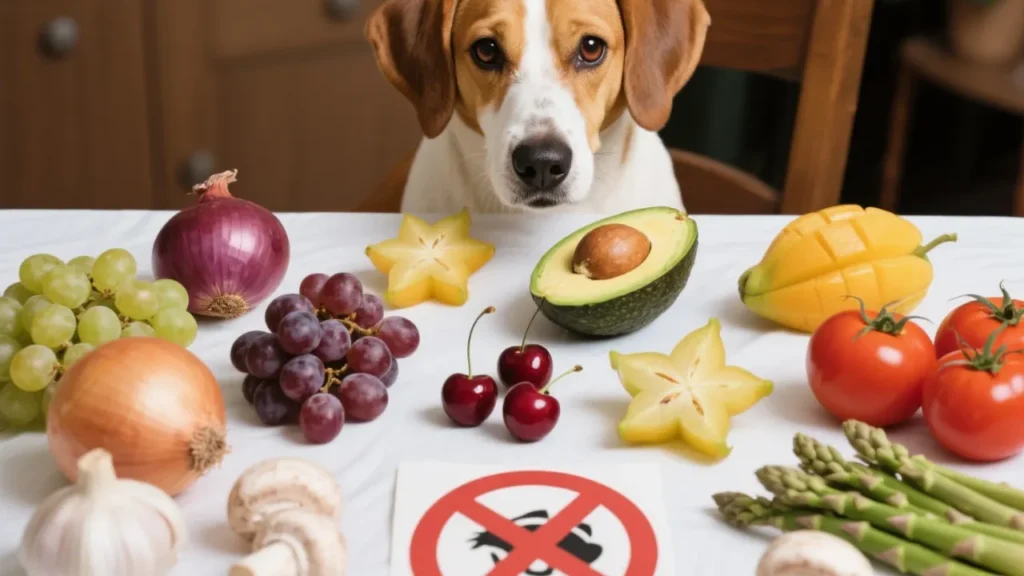The Essential Guide to Dog Kibble is here to help you navigate the world of dog food! Picking the right kibble for your furry friend can feel overwhelming. Don’t worry, though. This guide will break it all down for you.
You’ll learn about different types of kibble, top brands, and even some homemade recipes. Let’s dive into what you need to know to keep your pup healthy and happy!
Key Takeaways
- Choose kibble that fits your dog’s size and age.
- Look for high-quality ingredients like meat and veggies.
- Check for essential nutrients like protein and fat.
- Monitor your dog’s weight and adjust portions accordingly.
- Store kibble in a cool, dry place for optimal freshness.

Summary
What is Dog Kibble and Why It Matters
Dog kibble is dry dog food that comes in small, bite-sized pieces. You might be wondering, why does this matter? Well, kibble is a popular choice among dog owners for several reasons. First, it’s convenient. You can easily measure portions and store it without worrying about spoilage. Plus, it’s often more affordable than fresh or raw diets.
But there’s more to it than just convenience. The right kibble can provide your dog with a balanced diet, ensuring they get the nutrients they need to thrive. Think of it as their daily fuel. Just like we need a mix of proteins, carbs, and fats, dogs need a balanced diet too. Kibble can deliver that, depending on the brand and ingredients. For more insights on creating a balanced kibble diet, check out some expert tips.
So, when you’re choosing kibble, it’s important to understand what’s in it. Not all kibbles are created equal, and some can be packed with fillers or low-quality ingredients. This is why it matters to pay attention to what you’re feeding your furry friend. After all, a healthy dog is a happy dog!
The Essential Guide to Dog Kibble: Types You Should Know
When it comes to dog kibble, there are several types you should be aware of. Each type serves different needs and preferences. Here’s a breakdown:
- Standard Kibble: The most common type, made from a mix of meat, grains, and vegetables. It’s great for general feeding.
- Grain-Free Kibble: Ideal for dogs with grain allergies or sensitivities, this option skips grains like wheat and corn, using alternative carbs like sweet potatoes or peas instead.
- High-Protein Kibble: Perfect for active dogs or those needing to build muscle. This type contains more meat and fewer fillers, providing your pup with the energy they need.
- Limited Ingredient Kibble: Formulated with fewer ingredients for dogs with food sensitivities, helping to pinpoint potential allergens.
- Raw Kibble: A newer type that combines the convenience of kibble with the benefits of raw food, often freeze-dried or dehydrated to provide raw nutrition without hassle.
Understanding these types can help you make informed choices for your dog’s diet. Each dog is unique, so finding the right kibble can significantly impact their health and happiness. For additional guidance on selecting the right kibble, consider these five essential tips.
Best Dog Kibble Brands: Our Top Picks
Now that you know about the different types of kibble, let’s talk about some of the best brands out there. Here are our top picks:
- Orijen: Known for its high-quality ingredients and high protein content, Orijen uses fresh, regional ingredients and offers a variety of formulas.
- Blue Buffalo: This brand focuses on natural ingredients and has a range of options, including grain-free and high-protein recipes.
- Wellness Core: Great for active dogs, this brand offers grain-free, high-protein kibble that supports muscle health.
- Taste of the Wild: With unique protein sources like bison and roasted venison, this brand is excellent for dogs who need variety in their diets.
- Canidae: They offer limited ingredient diets and grain-free options, making it a solid choice for dogs with sensitivities.
- Merrick: Known for its high-quality meat and real whole foods, Merrick is a favorite among dog owners looking for nutritious options.
These brands have earned their reputations for a reason. They prioritize quality ingredients and balanced nutrition, which is what every dog deserves. For a more comprehensive analysis of top dog kibble brands, check out this complete analysis.
If you are thinking about changing your pet’s food, consider looking at this, but be sure to consult a veterinarian first about this kibble Dr. Harvey’s Canine Health Miracle Dog Food. and to read about this Reviews
Grain-Free Dog Kibble: Is It Right for Your Pup?
Grain-free dog kibble has become a hot topic in the pet food world. But is it right for your pup? The short answer is: it depends.
Some dogs have allergies or sensitivities to grains. If your dog is constantly scratching, has digestive issues, or shows signs of discomfort after eating, a grain-free diet might be worth considering. Ingredients like sweet potatoes and peas can provide necessary carbs without the potential allergens found in grains.
However, not all dogs need to avoid grains. Many dogs can digest grains just fine. A diet that includes grains can be beneficial, providing fiber and nutrients. It’s all about what works best for your furry friend. For more information on maximizing your dog’s nutrition, explore these powerful methods.
Before making any significant changes to your dog’s diet, it’s a good idea to consult your vet. They can help you determine if a grain-free diet is the best option based on your dog’s health and lifestyle.
High-Protein Dog Kibble: The Benefits for Active Dogs
If you’ve got an active dog, you might want to consider high-protein kibble. This type of food is packed with meat and other protein sources, which can be super beneficial for your pup’s energy levels and muscle health.
Active dogs need more protein to support their energy needs. Just like athletes need more fuel, so do our furry companions. High-protein kibble helps maintain their muscle mass and provides the energy they need for playtime, walks, and adventures. For more insights on boosting your dog’s health, check out these expert tips.
Plus, protein-rich diets can help with weight management. When dogs get enough protein, they often feel fuller, reducing the likelihood of overeating. It’s a win-win situation!
But make sure to choose a high-quality brand that sources its protein from real meat. Look for options that list meat as the first ingredient, and avoid those with fillers or by-products. Your active dog will thank you for it!
Understanding Dog Kibble Ingredients: What to Look For
When you’re shopping for dog kibble, it’s crucial to understand the ingredients list. Here are some key things to look for:
- Real Meat: The first ingredient should ideally be a specific type of meat, like chicken, beef, or fish, ensuring your dog gets high-quality protein.
- Whole Grains or Vegetables: If you’re choosing a kibble with grains, look for whole grains like brown rice or oats. If it’s grain-free, check for healthy carbs like sweet potatoes or peas.
- Healthy Fats: Omega fatty acids are important for your dog’s skin and coat. Look for sources like fish oil or chicken fat.
- Fruits and Vegetables: Ingredients like blueberries, carrots, and spinach can provide additional vitamins and minerals.
- Avoid Fillers and By-Products: Stay away from kibbles that list fillers like corn or soy, and avoid meat by-products, which can be lower quality.
Reading labels can feel overwhelming, but it’s worth it. Knowing what you’re feeding your dog can help you make better choices for their health. For additional ways to improve your dog’s diet with kibble, see these easy methods.
Dog Kibble Feeding Guide: How Much Should You Serve?
Feeding your dog the right amount of kibble is crucial for their health. Overfeeding can lead to obesity, while underfeeding can leave them lacking nutrients. So, how do you find the right balance?
Most kibble bags include feeding guidelines based on your dog’s weight. It’s a good starting point. For example, if you have a 20-pound dog, the bag might suggest feeding them around 1 to 1.5 cups of kibble per day.
But keep in mind that these are just guidelines. Factors like your dog’s age, activity level, and metabolism can affect how much they should eat. A puppy or an active dog may need more food, while an older or less active dog may need less.
And don’t forget about treats! If you’re giving your dog treats throughout the day, you’ll want to adjust their kibble portion accordingly to avoid overfeeding.
Regularly monitor your dog’s weight and body condition. If they seem to be gaining or losing weight, it might be time to adjust their portions. Your vet can also provide guidance tailored to your dog’s specific needs. For tips on transitioning to a new kibble, consider these proven methods.
Homemade Dog Kibble Recipes: A Fun Alternative
If you’re feeling adventurous, making homemade dog kibble can be a fun and rewarding experience! It allows you to control the ingredients and ensure your pup is getting the best nutrition possible. Here’s a simple recipe to get you started:
Homemade Chicken and Rice Kibble
Ingredients:
- 2 cups cooked chicken (shredded)
- 1 cup brown rice (cooked)
- 1/2 cup carrots (finely chopped)
- 1/2 cup peas
- 1/4 cup chicken broth (low sodium)
Instructions:
- Preheat your oven to 350°F (175°C).
- In a bowl, mix all the ingredients until well combined.
- Spread the mixture onto a baking sheet lined with parchment paper.
- Bake for about 30 minutes or until firm.
- Let it cool, then break it into small pieces.
This recipe is just a starting point. You can modify it based on your dog’s preferences and dietary needs. Just make sure to avoid ingredients that are toxic to dogs, like onions or garlic.
Homemade kibble can be a great way to bond with your pup and ensure they’re eating wholesome food. Plus, it’s satisfying to see them enjoy something you made just for them!
Dry Dog Food Benefits: Why Kibble is Popular
There’s a reason kibble is one of the most popular dog food choices. Here are some benefits that make it a go-to for many dog owners:
- Convenience: Kibble is easy to store and measure. No need for refrigeration, and it has a long shelf life.
- Cost-Effective: Compared to fresh or raw diets, kibble is often more affordable, making it accessible for many pet owners.
- Dental Health: The texture of kibble can help reduce plaque and tartar buildup on your dog’s teeth, promoting better dental health.
- Variety: There are countless brands and formulas available, so you can find one that meets your dog’s specific needs.
- Balanced Nutrition: Many kibbles are formulated to provide complete and balanced nutrition, ensuring your dog gets the right nutrients.
Kibble isn’t just a convenient option; it also supports your dog’s overall health and well-being. Just remember to choose a high-quality brand that meets your pup’s needs!
Organic Dog Kibble Options: Are They Worth It?
You might have noticed that organic dog kibble is becoming more popular. But is it worth the extra cost?
Organic kibble is made from ingredients that are grown without synthetic fertilizers or pesticides. This can mean fewer chemicals in your dog’s diet, which is a plus. Many organic brands focus on high-quality ingredients, which can lead to better nutrition.
However, it’s essential to do your research. Just because a kibble is labeled organic doesn’t automatically mean it’s the best choice for your dog. Look for brands that prioritize meat quality and overall nutritional balance. For insights into natural dog food diets, see this guide.
If you’re considering switching to organic kibble, it might be a good idea to consult with your vet. They can help you determine if it’s the right choice based on your dog’s health and dietary needs.
Dog Kibble Nutrition Facts: What You Need to Know
Understanding the nutrition facts of dog kibble can be tricky but is essential. Here are some key points to keep in mind:
- Protein Content: Look for kibble that has at least 18% protein for adult dogs and 22% for puppies. This ensures they’re getting enough protein for energy and muscle maintenance.
- Fat Content: Healthy fats are essential for your dog’s coat and skin. Aim for around 8-15% fat in your dog’s diet.
- Fiber: Fiber aids in digestion. A good kibble should have around 3-5% fiber.
- Vitamins and Minerals: Check for added vitamins and minerals, which help support your dog’s overall health.
Reading the nutrition facts can help you make informed decisions about what you’re feeding your dog. If you’re ever in doubt, don’t hesitate to ask your vet for advice.

Conclusion
In summary, choosing the right dog kibble is like finding the perfect pair of shoes for your furry friend—it needs to fit just right! By understanding the different types, brands, and ingredients, you can ensure your pup gets the nutrition they deserve.
Remember, a healthy dog is a happy dog, and the right kibble can set the stage for a tail-wagging life.
So, don’t hesitate to do a little homework before making a decision. After all, you want the best for your four-legged companion. If you’re hungry for more information and tips on pet care, feel free to explore more articles at Tech Havela. Happy feeding!
Frequently Asked Questions
What is dog kibble made of?
Dog kibble is usually made from meat, grains, and veggies.
How do I choose the best kibble for my dog?
Look for high-quality ingredients and your dog’s specific needs.
Is grain-free kibble better for my dog?
Not always. Some dogs need grains, while others do better without them.
How much kibble should I feed my dog?
Follow the guide on the bag. Adjust based on your dog’s size and activity.
Can I mix kibble with wet food?
Yes, mixing can make meals tastier and provide more moisture.
How long does kibble last?
Unopened kibble can last up to a year. Once opened, use it within 6 weeks.
Where can I find The Essential Guide to Dog Kibble?
You can find it online, in stores, or at your local library.
**Sidnir Vieira**
Founder of TechHavela
A passionate pet and tech content creator, helping dog owners across the U.S. make smarter decisions for their furry friends.



